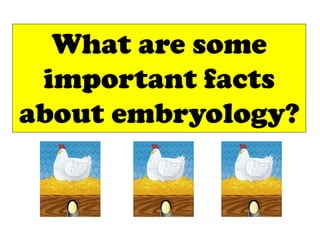
1. review emb. facts
- 1. What are some important facts about embryology?
- 2. Important Facts About Embryology Taught by Mrs. Ketterer Hen clucking ____________ = a female chicken; makes a ______________ noise Rooster _____________ = a male chicken; crows (cock-a-doodle do) _____________________________
- 3. hen The _________________ lays the eggs. A hen and rooster do not need to be together in order to produce _____________ an egg. need or do not need A hen ____________ produce an egg without a rooster. can can or cannot
- 4. In order for a hen to produce an egg, she must be at least ______ 5-6 months old. 24 It takes about __________ hours and __________ minutes for 29 an egg to form from start to finish. shell The ___________takes the longest to form. It takes about ____ hours! 20
- 5. The last thing that’s added to the shell before it’s laid is the ____________, pigment color white which is the _________of the shell. Chicken eggs can be ______________, brown blue green peach ______________, ______________, ______________, or _____________. Araucanas
- 6. beak Chickens do not have hands, they use their _______ to explore things. teeth A chicken cannot bite you because it doesn’t have any ____________.
- 7. Fertile _______________ egg = an egg in which an embryo will grow Infertile _______________ egg = the type of egg that you buy at the grocery store; an egg in which no embryo can grow In order for a hen to lay a fertile egg, rooster the hen must mate with a __________. Male cell joins the female cell creating a fertile egg.
- 8. Embryo = the baby chicken growing and developing inside the egg __________ Chick __________= the baby chicken once it makes a hole in shell and hatches 21 It takes _______ days for the embryo to grow and develop into a chick
- 9. Two Types of Incubation: Natural ______________ incubation = a hen sits on the egg to keep it warm Artificial ______________ incubation = using an incubator to keep the eggs warm
- 10. During natural incubation, the hen helps to provide the 4 primary needs of the embryo. heat The hen provides ___________ by sitting on the eggs. The hen’s body temperature is very hot. Because the eggs are cooler than the air around them, water vapor in the air starts to condense. This humidity creates _________________. The hen also brings back moisture from the grass. exercise The hen provides _________________ by turning the eggs with her feet, beak, or body about 99 times per day. unpolluted air The embryos also need _______________________. The embryos can pores breathe through tiny holes in the egg shell called __________. There are 6,000 8,000 ____________ to _____________ in each egg shell!
- 12. The embryo has three sources of food in the egg: yolk 1 - The main source of food is the ________________. It provides the embryo with vitamins minerals fat _________________, _________________, and _________________.
- 13. The embryo has three sources of food in the egg: albumen 2 - The __________________ is also used as a food source for the embryo. thick thin There are two layers of albumen, ________________ and _______________. The protein water albumen provides _________________ and ________________.
- 14. The embryo has three sources of food in the egg: shell calcium 3 - The third source of food is the ___________ . The embryo gets ______________ bones from the shell to help build strong ______________________.
- 15. weaker Toward the end of the 21 days, the egg shell will get ____________ because calcium the embryo is using the _____________ in the egg shell for food. This will help the embryo to get out of the shell once it has developed into a chick. does not During the 21 days, the egg ______________________ grow in size. does or does not